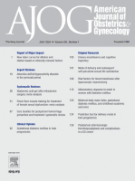Epidural-associated hypotension is more common among severely preeclamptic patients in labor - 27/09/12
Résumé |
Objective |
To determine whether severe preeclampsia is associated with increased maternal hypotension or fetal heart rate abnormalities after epidural anesthesia placement during labor.
Study Design |
Retrospective cohort study of 100 women with severe preeclampsia and 100 normotensive controls who underwent epidural anesthesia during labor from May 2008 to July 2011. Blood pressures during 2-minute time intervals for 20 minutes postepidural were compared with baseline measurements. Fetal heart rate abnormalities and related interventions were evaluated according to study group.
Results |
Severe preeclampsia was associated with a greater percent decrease in blood pressure across all intervals and more episodes of systolic and diastolic hypotension after dosing. Severely preeclamptic women received more intravenous pressor support and developed more Category II fetal heart rate tracings, minimal variability, and late decelerations after dosing.
Conclusion |
Severe preeclampsia is associated with more frequent hypotension, need for pressor support, and fetal heart rate abnormalities after epidural anesthesia placement during labor.
Le texte complet de cet article est disponible en PDF.Key words : epidural analgesia, hypotension, labor, preeclampsia
Plan
| The authors report no conflict of interest. |
|
| Reprints will not be available from the authors. |
|
| Cite this article as: Vricella LK, Louis JM, Mercer BM, et al. Epidural-associated hypotension is more common among severely preeclamptic patients in labor. Am J Obstet Gynecol 2012;207:335.e1-7. |
Vol 207 - N° 4
P. 335.e1-335.e7 - octobre 2012 Retour au numéroBienvenue sur EM-consulte, la référence des professionnels de santé.
L’accès au texte intégral de cet article nécessite un abonnement.
Déjà abonné à cette revue ?

